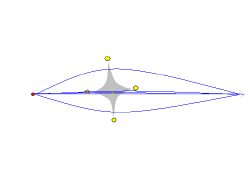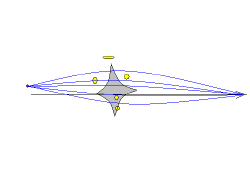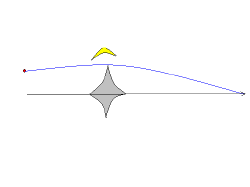|
Cosmology:
Dr. Ned Wright's colosmology tutorial: link
Basic concepts:
 | dark matter (Wiki) |
 | dark energy (Wiki) |
 | An web version of the ARA&A review on baryonic
dark matter (here). |
 | Lambda cold dark matter model (Lambda_CDM,
see Wiki), the
standard model of cosmology. |
 | The time line of the cosmology evolution
according to Big Bang theory (from Wiki):
Zero time: The Augustinian era ==> String theory epoch ==> 10-43s:
The Planck epoch ==> 10-35s: The grand unification epoch
==> 10-32s: The inflationary epoch ==> 10-12s:
The electroweak epoch ==> 10-6s: The quark epoch ==>
1s: The hadron epoch ==> 3s: The lepton epoch ==> 380,000 years: The
photon epoch (matter domination: 70,000 yrs; Recombination 380,000yrs)
==> The dark ages ==> structure formation ==> Reionization ==>
Formation of Stars ==> 500,000,000 yrs: Formation of galaxies ==>
Formation of groups, clusters and superclusters ==> 8 billion years:
Formation of our solar system ==> 13.7 billion year: today. |
 | 13.7+-2 billion years ago: Big Bang ==> z=1100, Recombination ();
z=10~6, Reionization; |
 | List of particles:
elementary fermions (quarks and leptons and their anti-particles) and
elementary bosons (photon, W, Z, Gluon, Graviton, Higgs)
and
hypothetical particals
==> composite particles: hadrons (baryons and mesons)
==> neuclei
==> atoms
==> molecules
==> condensed matter
==> other particles.
(See the original Wiki page here) |
 | |
 | Weak lensing and dark matter(DM). (from Kiichi Umetsu's lunch talk on 9
March, 2007 at ASIAA)
 | Weak and strong lensing: Radiation from a
distant galaxy can be lensed by the gravitational field of a nearer
galaxy cluster when the two overlap along the line of
sight. The lensing forms several images of the distant galaxy around the lensing galaxy
cluster. Theoretically, a normal galaxy cluster lense will produce 5
images of the lensed distant galaxy. If the distant galaxy is shifted a
little away from the lense center, the position, intensity,
and shape of the 5 images will change and several images tend merge with
each other. When the distant galaxy is shifted far enough away from the
lense center, only one image can be seen (at the
same side of the distant galaxy). It's called Weak
Gravatational Lensing (WGL) when only one image of the distant
galaxy can be seen, otherwise, it's called Strong Gravatational Lensing (SGL). (Following figures from left to right: strong,
intermediate and weak lensing.)
   |
 | Examples of gravitational lensing:
 | Abell 1689: red shift Z = 0.183,
distance = 550 kpc, the strongest lensing cluster known to date. |
 | Abell 2218: an example of weak
lensing. |
|
 | weak shear: If we assume the lensed image is an
ellipse, the major and minor axis a and b define an ellipticity r =
(a-b)/(a+b). One can define the ellipticity in two different coordinate
systems so as to
describe both the shape and orientation of the elliptical lensed image,
say, r1 and r2. Then, we have a shear matrix ((r1,r2),(r2,r1)) that fully
describes the geometry of the lensed image. |
 | Dark matter: It's said that the universe is composed of 74% of dark energy (DE), 22% of dark matter
(DM), and only 4% of baryons. It's still not clear what DM is. DM might be
the so called weak interaction massive particals (WIMPs), such as
Neutralino. DM can be divided into two classes: hot dark matter (HDM)
and cold dark matter (CDM). People argue that, based on some
simulations, HDM is not the major component of our Universe, because the
observed power spectral (power versus spatial wavelength) of galaxies
and CMB don't agree with HDM model. Therefore, only CDM model is favorable. |
|
 | Multi-resolution analysis (MRA) of
computational cosmology. (from the colloquium talk by Prof. Long-Long Feng
on May 30, 2007 at ASIAA)
 | decomposite the n point correlation function onto a serial of complete
and orthogonal base functions with different resolutions. |
|
 | Relationship between dark matter and galaxies. (From the
colloquium talk by Dr. Houjun Mo on May 30, 2007 at ASIAA)
|
 | Whether dark matter affect the energy level structure or populatioin of normal matter? If yes, how can we observe the
effects through radiation? |
 | Torsion cosmology and the oscillating universe
(from colloquium talk by Dr. James Nester at ASIAA on Sep. 21, 2007)
Geometry of the space includes two aspects: metric and connection.
Metric of the universe is related to mass that
produces curvature to the space; connection of
the universe is related to spin that causes torsion to the space. Torsion of a space can be
imagined as such: When a reference frame in a space with torsion translate
for a distance, the direction of the reference frame will rotate. Although
an oscillating universe usually means the recurrence of Big Bang and Big
Crunch, in this talk another kind of oscillating
universe in which the torsion oscillates periodically while the whole
universe keeps homogeneous and isotropic was shown to be possible in their
simple model. In another word, the universe could be periodically twisting
itself. This possibility gives a new view of the currently accelerating
universe, without the help of the Einstein constant Lambda in the equation
of cosmology. |
 | Detection of integrated Sachs-Wolfe effect by
cross-correlation of the CMB and radio galaxies. (from the lunch talk
given by Dr. Guo-Chin, Liu at ASIAA on Sep. 17, 2007)
Sachs [sa:hs] - Wolfe effect is caused by scattering in galaxies after the
recombination stage of the early universe. Polarization
component of the CMB images are found to be
correlated with radio galaxy distributions. Such correlation allows the
separation of the Sachs-Wolfe contribution out of the CMB. |
 | The Quadrupole Power Spectrum for the SDSS Liminous Red
Galaxies. (from the lunch talk by Dr. Hiroaki Nishioka at ASIAA on
Jan. 7, 2008)
 | When
converting redshift into radial distance, the effect of peculiar
velocity of galaxies will cause distorsion to the 3D distribution of the
galaxies. There are two related particular effects related to galaxy
clusters: Alcock-Paczynski effect and finger-of-god effect. A galaxy
cluster is usually collapsing due to gravity force. At larger scale,
e.g., the outer skirt of the cluster, the infalling velocity of the
galaxies will result in a overestimate of distance at the near side of
the cluster and a underestimate of distance at the far side of the
cluster, which will result in over estimate of galaxy number density in
the cluster (Alcock-Paczynski effect). At
smaller scale, e.g., near the center of a galaxy cluster, the infalling
velocity is so large and so the overestimate and underestimate of the
galaxy distance is so large that the far side galaxies will be
mis-placed to near side of the cluster and the near side galaxies will
be mis-placed to the far side (finger-of-god
effect).
|
 | Both
the Alcock-Paczynski and finger-of-god effects only affect the radial
distribution of galaxies when radial distance is calculated from
redshift. Therefore, with the 3D Cartesian coordinate (X, Y, Z, with Z
along the line of sight), the power spectrum along Z axis is distorted
by the above effects while it remains the intact in both X and Y
directions. In this case, the 3D power spectrum P(k_x, k_y, k_z)
collapses into a 2D power spectrum P(k_z,mu) where mu is the cosine of
the angle of the considered direction w.r.t. Z axis, the line-of-sight.
This dependence of power spectrum on direction cosine mu can be
decomposed into different multipole components: monopole, dipole,
quadrupole, ... Among the multipole components, the
quadrupole component is the best one to reflect the Alcock-Paczynski and
finger-of-god effects. This quadrupole component of the power
spectrum is named quadrupole power spectrum.
Now, quadrupole power spectrum has been constructed from the 3D
distribution of liuminous red galaxies in SDSS database using galaxy
number density. It was found that the quadrupole power spectrum changes with redshift,
which may indicate the time variation of galaxy distributions during the
evolution of the cosmos. |
 |
|
|
|
![]()